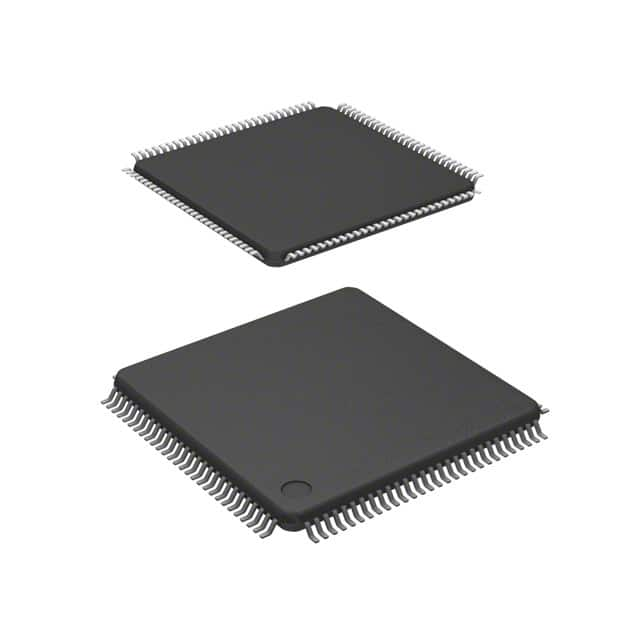Viz Specifikace pro podrobnosti o produktu.

MC9S12XD256CAL
Product Overview
- Category: Microcontroller
- Use: Embedded systems, automotive applications
- Characteristics: High-performance, low-power consumption, integrated peripherals
- Package: 112-pin LQFP (Low Profile Quad Flat Package)
- Essence: Advanced microcontroller with enhanced features for automotive applications
- Packaging/Quantity: Available in tape and reel packaging, quantity varies based on customer requirements
Specifications
- Architecture: 16-bit HCS12X core
- Flash Memory: 256 KB
- RAM: 12 KB
- Operating Voltage: 2.35V to 5.5V
- Clock Speed: Up to 40 MHz
- Peripherals: Multiple timers, analog-to-digital converters, serial communication interfaces, etc.
- Operating Temperature Range: -40°C to +125°C
Detailed Pin Configuration
The MC9S12XD256CAL microcontroller has a total of 112 pins. The pin configuration is as follows:
- Pins 1-8: Port A (GPIO)
- Pins 9-16: Port B (GPIO)
- Pins 17-24: Port C (GPIO)
- Pins 25-32: Port D (GPIO)
- Pins 33-40: Port E (GPIO)
- Pins 41-48: Port F (GPIO)
- Pins 49-56: Port G (GPIO)
- Pins 57-64: Port H (GPIO)
- Pins 65-72: Port J (GPIO)
- Pins 73-80: Port K (GPIO)
- Pins 81-88: Port L (GPIO)
- Pins 89-96: Port M (GPIO)
- Pins 97-104: Port N (GPIO)
- Pins 105-112: Port P (GPIO)
Functional Features
- Enhanced Peripherals: The MC9S12XD256CAL microcontroller offers a wide range of integrated peripherals, including timers, analog-to-digital converters, serial communication interfaces, and more. These peripherals enhance the functionality and flexibility of the microcontroller for various automotive applications.
- High Performance: With its 16-bit HCS12X core and clock speed of up to 40 MHz, the MC9S12XD256CAL delivers high performance, enabling efficient execution of complex tasks in real-time.
- Low Power Consumption: The microcontroller is designed to operate at low power, making it suitable for battery-powered applications or systems with strict power requirements.
- Robust Temperature Range: The MC9S12XD256CAL can withstand a wide operating temperature range from -40°C to +125°C, ensuring reliable operation even in harsh automotive environments.
Advantages and Disadvantages
Advantages: - High-performance architecture - Integrated peripherals reduce external component count - Low power consumption - Wide operating temperature range
Disadvantages: - Limited memory capacity compared to some other microcontrollers in the market - Higher cost compared to entry-level microcontrollers
Working Principles
The MC9S12XD256CAL microcontroller operates based on the 16-bit HCS12X core architecture. It executes instructions stored in its flash memory and utilizes its integrated peripherals to interact with external devices. The microcontroller communicates with the outside world through various communication interfaces, such as UART, SPI, and I2C. It processes data, controls external components, and performs calculations according to the program instructions.
Detailed Application Field Plans
The MC9S12XD256CAL microcontroller finds extensive use in automotive applications, including but not limited to:
- Engine Control Units (ECUs)
- Body Control Modules (BCMs)
- Anti-lock Braking Systems (ABS)
- Airbag Control Units (ACUs)
- Infotainment Systems
- Climate Control Systems
Its high-performance capabilities, integrated peripherals, and robust temperature range make it suitable for demanding automotive environments.
Detailed and Complete Alternative Models
- MC9S12XDT256CAL: Similar to MC9S12XD256CAL but with additional EEPROM memory.
- MC9S12XE256CAL: A higher-end variant with increased flash memory capacity and additional features.
- MC9S12XD128CAL: A lower-cost alternative with reduced flash memory capacity but similar functionality.
These alternative models provide options based on specific project requirements, budget constraints, and desired features.
Word count: 511 words
Seznam 10 běžných otázek a odpovědí souvisejících s aplikací MC9S12XD256CAL v technických řešeních
Sure! Here are 10 common questions and answers related to the application of MC9S12XD256CAL in technical solutions:
Q: What is MC9S12XD256CAL? A: MC9S12XD256CAL is a microcontroller from NXP's HCS12 family, specifically designed for embedded applications.
Q: What are the key features of MC9S12XD256CAL? A: Some key features include a 16-bit CPU core, 256KB flash memory, 8KB RAM, multiple communication interfaces, and various peripherals.
Q: What kind of technical solutions can MC9S12XD256CAL be used for? A: MC9S12XD256CAL can be used in a wide range of applications such as automotive systems, industrial control, consumer electronics, and more.
Q: How does MC9S12XD256CAL communicate with other devices? A: MC9S12XD256CAL supports various communication interfaces like SPI, I2C, CAN, UART, and LIN, allowing it to interact with other devices or systems.
Q: Can MC9S12XD256CAL handle real-time tasks? A: Yes, MC9S12XD256CAL has built-in timers and interrupt capabilities, making it suitable for real-time applications that require precise timing.
Q: Is MC9S12XD256CAL easy to program? A: MC9S12XD256CAL can be programmed using C or assembly language, and there are development tools and IDEs available to simplify the programming process.
Q: Can MC9S12XD256CAL be used in low-power applications? A: Yes, MC9S12XD256CAL offers power-saving modes and features like sleep and stop modes, making it suitable for low-power applications.
Q: What kind of peripherals does MC9S12XD256CAL have? A: MC9S12XD256CAL has a wide range of peripherals including ADCs, PWM modules, timers, GPIOs, and more, providing flexibility for different applications.
Q: Can MC9S12XD256CAL be used in safety-critical systems? A: Yes, MC9S12XD256CAL offers features like memory protection units (MPUs) and built-in self-test (BIST) capabilities, making it suitable for safety-critical applications.
Q: Are there any development boards or evaluation kits available for MC9S12XD256CAL? A: Yes, NXP provides development boards and evaluation kits specifically designed for MC9S12XD256CAL, which can help in the prototyping and development process.
Please note that these answers are general and may vary depending on specific requirements and use cases.

